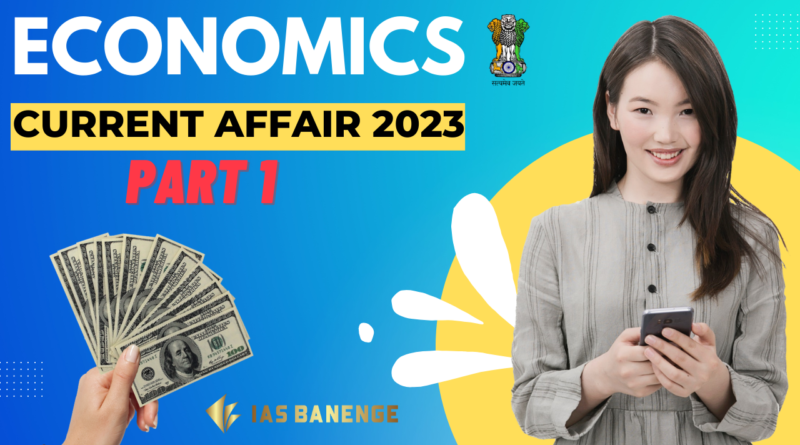Economics Current Affairs for UPSC 2023 I PART -1
GROWTH, DEVELOPMENT AND POVERTY ALLEVIATION
1.GROWTH AND DEVELOPMENT
The gap between Gross Domestic Product (GDP) and Gross Value Added (GVA) of India increased.
Difference between GDP and GVA
| GDP (Gross Domestic Product) | GVA (Gross Value Added) | |
|---|---|---|
| Definition | The total monetary value of all goods and services produced within a country’s borders during a specified period of time (usually one year) | The value of goods and services produced by a company, industry, or sector, minus the cost of inputs and raw materials |
| Calculation | GDP = private consumption + gross investment + government spending + (exports – imports) | GVA = total output value – intermediate consumption |
| Scope | Measures the total economic output of a country, including goods and services produced by both domestic and foreign entities within the country’s borders | Measures the value added by a particular company, industry, or sector to the economy, without including the value of goods and services produced by other sectors |
| Usefulness | Used to compare the economic performance of different countries or regions | Used to evaluate the productivity and efficiency of a specific sector or industry |
In India, GVA at basic prices became the primary measure of output across various sectors in 2015 to conform to the UN System of National Accounts (SNA), 2008. The National Statistical Office (NSO) provides quarterly and annual estimates of GVA for eight broad sectors covering goods and services in India.
The difference between GDP and GVA is that GDP is calculated at market prices while GVA is calculated at basic prices. Another reason for the gap between GDP and GVA growth is that when subsidies are high and taxes are low, GVA growth is higher than GDP growth. Conversely, when tax collection is high and subsidies are low, GDP growth is higher than GVA growth.
2.HUMAN DEVELOPMENT REPORT (HDR)
“Uncertain times, unsettled lives: Shaping our Future in a Transforming World” – UNDP 2021/22 Human Development Report
Human development is the process of expanding people’s freedoms and opportunities while enhancing their well-being. The UNDP’s HDR report, which was first released in 1990, measures human development achievements in three primary dimensions: a long and healthy life (measured by life expectancy), access to knowledge (measured by expected and mean years of schooling), and a decent standard of living (measured by GNI per capita).
Key Findings of the 2021/22 report
The global HDI has experienced a decline for two consecutive years (2020 and 2021), reversing five years of progress. India is ranked 132 out of 191 countries in terms of HDI, with Sri Lanka (73), China (79), Bangladesh (129), and Bhutan (127) ranking higher than India. However, India is bridging the human development gap between men and women at a faster rate compared to the rest of the world.
Reasons behind HDI Decline
Globally, a combination of the COVID-19 pandemic, Russia’s invasion of Ukraine, and climate crises has resulted in a decline in the human development score. Life expectancy worldwide has dropped in 2021 from 2019. In India, the human development value has fallen in 2021-22 from 2020, placing the country in the medium human development category. The decline in India’s human development is due to a drop in life expectancy, expected years of schooling at 11.9 years, mean years of schooling at 6.7 years, and a 5% decrease in per capita income in terms of purchasing power parity during 2019 and 2021-22.
3.POVERTY ESTIMATES
“Different Estimates of Poverty and Inequality in India: IMF and World Bank Perspectives” – Authors’ AffiliationsThe Economic Advisory Council to the Prime Minister (EAC-PM) has released the State of Inequality in India report. Poverty is measured as either absolute or relative poverty, based on a poverty threshold or poverty line, with people falling under this threshold/line being considered poor. Absolute poverty represents the lack of sufficient resources to secure basic life necessities, such as safe drinking water, food, or sanitation, while relative poverty represents the worse income and resource status of a person or a household than what is thought to be adequate or socially acceptable in the society in which they live.
Poverty Estimation in India
| Committee | Methodology | Findings |
|---|---|---|
| Tendulkar Committee, 2009 | Based on Monthly Per Capita Consumption Expenditure (MPCE) computed on the basis of data from the National Sample Survey Organisation (NSSO) | 21.9% of total population was below poverty line in 2011-12 |
| Rangarajan Committee, 2014 | Based on an independent large survey of households by Center for Monitoring Indian Economy (CMIE) | 29.5% of total population was below poverty line in 2011-12 |
| NITI Aayog’s National MPI: Baseline Report | Based on 12 parameters (10 indicators of MPI and two new indicators antenatal care and bank account under Health and Standard of Living) | 25.01% of India’s population as multidimensionally poor |
| Alagh Committee (1979) | Based on calorie intake, distribution of minimum consumption requirements among different expenditure classes | 54.9% of the rural population and 45.3% of the urban population were below the poverty line in 1973-74 |
| Lakdawala Committee (1993) | Based on calorie intake, including non-food items such as clothing, education and health expenses in the poverty line calculation | 35% of the total population was below the poverty line in 1993-94 |
4.DEVELOPMENTS ON FINANCIAL INCLUSION
The World Bank’s ‘Global Findex Database 2021’ shows that India is one of seven countries where half of the world’s 1.4 billion unbanked adults live. In an effort to address this issue, India Post Payments Bank (IPPB) launched ‘Fincluvation’ to collaborate with fintech start-ups to create innovative financial solutions. Additionally, the Reserve Bank of India (RBI) released the Financial Inclusion Index (FI-Index) to measure the extent of financial inclusion in India across banking, investments, insurance, and pensions. The index improved to 56.4 in FY 21-22 from 53.9 in 2020-21, with growth seen across all sub-indices.
5.KEY CONCEPTS ON GROWTH, DEVELOPMENT AND POVERTY ALLEVIATION
| Term/Phrase | Definition/Description |
|---|---|
| Glass cliff | A situation in which women and marginalized groups are promoted to leadership roles during times of crisis |
| Technical recession | Two consecutive quarters of decline in output, often caused by a one-off event |
| Doom loop | The circle of vulnerability where a country’s banking system can be severely hurt by volatility in the price of sovereign bonds they hold for reserves |
| Creative economy | The interface between creativity, culture, economics, and technology in a contemporary world dominated by images, sounds, texts, and symbols |
| Twin city development | Transforming existing cities and developing new satellite/theme townships that offer high quality of life |
| Urban-20 | A platform for G20 countries’ cities to discuss important issues of urban development and propose solutions |
| Twin transition | A combined approach that recognizes the opportunity for technology and data to drive sustainability goals |
| Cost of living index | A comparison of the prices of more than 200 goods and services in cities worldwide |
| Developed country | A country classified by the UN as having a developed economy |
| Financial Intermediary Fund (FIF) | A new fund established for pandemic prevention, preparedness, and response with financial commitments from multiple countries |
FISCAL POLICY
1.STRENGTHENING STATE FINANCES
“Central Government Raises Alarm Over Mounting Debt Burden and Deteriorating Fiscal Situation in Some States Due to Excessive Freebies”
State Finances and Initiatives taken to Support State Finance
The state finances in India include tax and non-tax revenues, tax devolution and grants from the central government. Initiatives have been taken to support state finance such as reduced borrowing limits, inclusion of off-budget borrowings, lowering of ways and means advances limit, and a scheme for special assistance to states for capital investment. The reform-linked additional borrowing space to state governments allows for additional borrowing of 1% of their GSDP to implement critical reforms such as One Nation One Ration Card System, Ease of doing business reform, Urban Local body/utility reforms, and Power Sector reforms.
2.STATE’S FISCAL RESPONSIBILITY AND BUDGET MANAGEMENT (FRBM)
“State-owned Companies’ Borrowing to be Considered under States’ FRBM Limit, Informs Ministry of Finance”
The borrowing by states has an impact on their revenue deficit and fiscal deficit, and under Article 293(3) of the Constitution, the state requires the consent of the Union Government to raise any loan if there is still an outstanding part of a loan. All states have enacted their FRBM Act as per the 12th Finance Commission recommendation, and its compliance is monitored by the respective state legislatures. The normal net borrowing ceiling of each state is fixed by the Union Government in the beginning of each financial year, and for the FY 2022-23, the NBC of the state has been determined at 3.5% of Gross State Domestic Product (GSDP) based on the 15th Finance Commission recommendation.
3.MUNICIPAL FINANCING
RBI releases first comprehensive analysis of municipal finances covering 201 corporations across all states.
The 74th Amendment Act of 1992 institutionalized urban local bodies (ULBs) as the third tier of the government to promote grassroots level democracy. However, it does not provide for a corresponding ‘municipal finance list’ in the Constitution, and it has been left completely to the discretion of the state governments.
4.DIGITAL TAX
G24 grouping objects to proposal on making sovereign commitments to delay global tax deal implementation.
The digital services tax is a part of the OECD’s two-pillar plan of 2021, which has been agreed upon by 138 countries, including India. The plan aims to reform global taxation rules and address the tax challenges that arise from the digitalization of the economy.
OCED’s Inclusive framework on BEPS
Base Erosion and Profit Shifting (BEPS) is a tax planning strategy used by multinational enterprises (MNEs) that exploits gaps and mismatches in tax rules to avoid paying tax. To address tax avoidance, the OECD has developed a framework based on two pillars – reallocation of taxing rights and a global anti-base erosion mechanism. The global minimum tax, also known as the global minimum corporate tax rate, is a part of the inclusive framework on BEPS and aims to prevent multinationals from paying low taxes or no tax by booking their profits in tax havens, and make them pay taxes wherever they operate or conduct business, even if they do not have physical presence in the country.
About Digital Tax in India
India has introduced a digital tax called the Equalization Levy (EL) on non-resident digital companies, such as Google, for their online advertisement services. The scope of EL has been expanded as part of the Finance Act 2020 to include a 2 percent Digital Service Tax (DST) on foreign e-commerce companies like Amazon and Flipkart, with an annual turnover of ₹2 crore or more. This tax is aimed at ensuring that non-resident digital service providers pay their fair share of tax on revenues generated in the Indian digital market. The DST is set to stay beyond 2023, as a global tax deal which was to replace such levies by individual nations by then faces implementation challenges.
Implementation challenges:
There are divergent interests between European countries and the US when it comes to international tax policies. European countries have prioritized the issue of digital taxation, while the US has prioritized the global minimum rate. However, both US and European legislators are now struggling to pass the necessary laws to implement the tax deal. For example, Hungary has recently withdrawn its support for the minimum corporate tax in the EU, adding to the challenges faced in implementing the global tax deal.
5.TAXATION OF VIRTUAL DIGITAL ASSETS (VDAS)
CBDT Amends Income Tax Rules to Specify Compliance with TDS Provision on Virtual Digital Assets (VDAs).The Finance Bill 2022 has defined Virtual Digital Assets (VDAs) under the IT Act, 1961 as any information or code or number or token that can be transferred, stored or traded electronically through cryptographic means or otherwise. This includes non-fungible tokens (NFTs), cryptocurrencies, dematerialized shares, promotional currencies, and e-books. However, the RBI has highlighted the risks associated with cryptocurrencies, such as the dollarization of the economy, which would be against India’s sovereign interest. While some countries like El Salvador and the Central African Republic have allowed cryptocurrencies as legal tender or made them their official currency, they are not promoted as such in India.
Taxation of VDAs
Income from the transfer of Virtual Digital Assets (VDAs) will be taxable at a flat rate of 30%, and no deductions will be allowed, including the inability to offset it against any other losses. Only the cost of acquisition will be allowed as a deduction when computing income. Additionally, if a VDA is gifted, it will be taxable at the hands of the recipient.
Regulation of VDA Advertising
| Regulating Authority | Actions Taken |
|---|---|
| Consumer Protection Act 2019 | – Defines penalties for endorsers in case of misleading advertisement<br>- Holds endorsers accountable if they have not done due diligence |
| Advertising Standards Council of India (ASCI) | – Issued guidelines for the promotion and advertisement of crypto and NFTs<br>- Mandates all VDA products and services to carry disclaimers regarding crypto products and NFTs<br>- Is a voluntary self-regulatory organization established in 1985 to protect Indian consumers’ interests through self-regulation in advertising<br>- Issues non-legally binding advertisement codes and guidelines<br>- Cable Television Networks (Amendment) Rules, 2006 make it mandatory for all advertisements carried by cable services to be compliant with the ASCI code |
Concerns over VDA
Virtual Digital Assets (VDAs) are highly risky assets and largely unregulated, leaving no regulatory recourse for any loss from such transactions. They pose a threat to the financial system stability and risk the dollarization of a part of the Indian economy, going against the country’s sovereign interest and undermining RBI Monetary policy influence. There is also a risk of anonymous use for making it liable to be misused for terror financing, money laundering, and drug trafficking.
6.KEY CONCEPTS AND INFORMATION ON FISCAL POLICY
| Topic | Description |
|---|---|
| Twin Deficit | Ministry of Finance warns of reemergence of twin deficit problem with higher commodity prices and rising subsidy burden. Twin deficit refers to a nation’s current account deficit and a simultaneous fiscal deficit. |
| Single Nodal Agency (SNA) dashboard | Ministry of Finance launches SNA dashboard of the Public Financial Management System (PFMS) to ensure effective leveraging of technology in public finance. SNA model requires the states to notify an SNA for each Centrally Sponsored Scheme (CSS) which will open a unique bank account at a commercial bank responsible for all transactions related to the implementation of the particular CSS. |
| Status Report on India’s External Debt 2021-22 | Released by the Department of Economic Affairs, report highlights 8.2% rise in India’s external debt to stand at $620.7 billion on March 31, 2022. External debt refers to ‘money borrowed from outside the country and has to be paid back in currency in which it is borrowed’. |
| Tobin Tax | Tobin tax is a tax levied on spot currency conversions, with the intention of disincentivizing short-term currency speculation. |
| Windfall Tax | Centre has cut windfall tax on crude producers, scraps petrol exports levy. Windfall tax is a one-off tax imposed by a government on a company, levied on an unforeseen or unexpectedly large profit, especially unfairly obtained. It is only levied in public interest. |
| GAAR (General Anti-Avoidance Rule) | GAAR is an anti-abuse provision invoked by tax authorities to strike down unacceptable tax avoidance practices. It is a provision of last resort and used to strike down those lawful practices which undermine intention of tax laws, i.e. misuse or abuse of law. |
| Central Board of Direct Taxes (CBDT) guidelines on TDS | Guidelines are related to applicability of new TDS provision regarding benefits received in a business or profession. Section 194R requires deduction of TDS at the rate of 10% by any person providing any benefit or perquisite, exceeding ₹20,000 in a year to a resident. CBDT clarified that section 194R would apply on distribution of free samples to the hospital for doctors receiving free samples of medicines while employed in a hospital. |
| Double Taxation Avoidance Agreement (DTAA) | Income Tax Appellate Authority (ITAT) ruled that Google India’s payment to Ireland unit was not royalty and therefore not subject to withholding tax. DTAA is a tax treaty signed between India and another country so that taxpayers can avoid paying double taxes on their income earned from source as well as residence country. |
| RNOR (Resident but Not Ordinarily Resident) | RNOR represents a person who does not qualify as an ordinary resident. It includes a person who spends over 120 but less than 182 days and earns ₹15 lakh or more from assets in India. |
| Automatic Exchange of Information (AEOI) | Funds parked by Indian individuals and firms in Swiss banks jumped to a 14-year-high in 2021 as per annual data from Switzerland’s central bank. AEOI refers to the exchange of information between countries’ tax authorities regarding financial accounts held by non-residents in their countries. |





Great blog! I am loving it!! Will be back later to read some more. I am taking your feeds also.
Pingback: Economics Current Affairs for UPSC 2023 I PART -4 - Ias Banenge